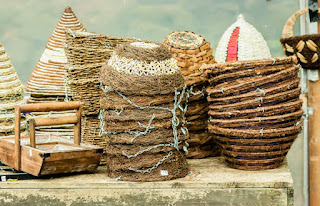Kerala's Handicrafts: A Story of Tradition and Craftsmanship

Kerala, a state known for its cultural richness and artistic heritage, is also home to a diverse range of handicrafts that reflect the skill and creativity of its people. These handicrafts are not just products of art; they are stories woven into fabric, carved into wood, and molded into metal, representing centuries of tradition and craftsmanship. From the coir products of the backwaters to the intricate metalwork and woodcarvings, each handicraft of Kerala has a unique story to tell. Let's delve into the world of Kerala's handicrafts and appreciate the artistry and tradition behind them.
1. The Coir and Canework of Kerala
- Image Suggestion: Coir products, like mats or baskets, and canework being crafted or displayed.
- Content: Kerala is renowned for its coir and canework, thanks to the abundance of coconut trees and reeds in the region. The coir, made from the fibrous husk of coconuts, is used to create a wide range of products including mats, rugs, and ropes. Canework is also popular, with artisans weaving beautiful baskets, furniture, and other household items. These products are not only eco-friendly but also durable and aesthetically pleasing.
2. Kathakali Masks and Costumes
- Image Suggestion: Colorful Kathakali masks and costumes, or artisans crafting them.
- Content: The elaborate masks and costumes used in Kathakali, a classical dance-drama of Kerala, are works of art in themselves. The masks are vividly painted and intricately designed, representing various mythological characters. These costumes and masks, crafted by skilled artisans, play a crucial role in bringing the stories of Kathakali to life.
3. Metalwork: Aranmula Kannadi and More
- Image Suggestion: The unique Aranmula Kannadi (metal mirror) or other exquisite metal crafts.
- Content: Kerala's metalwork is famous, especially the Aranmula Kannadi, a unique type of mirror made from a special metal alloy, not glass. These handcrafted metal mirrors are a symbol of tradition and are considered auspicious to keep in homes. Besides this, brass and bell metal are used to make various traditional lamps, utensils, and decorative items, showcasing the metalworking skills of Kerala's artisans.
4. Woodcarving: A Testament to Skill
- Image Suggestion: Artisans at work on woodcarvings or finished wooden sculptures and furniture.
- Content: Woodcarving is a highly developed art form in Kerala, with the wood from jackfruit trees, rosewood, and sandalwood being commonly used. Artisans create everything from religious figures and mythological motifs to traditional furniture and musical instruments. The woodcarvings of Kerala stand out for their precision, detail, and beauty.
5. Handloom and Textiles: The Weave of Tradition
- Image Suggestion: Handloom weavers at work or displays of Kerala sarees and other textiles.
- Content: Kerala is known for its handloom textiles, particularly the traditional Kerala saree with its gold zari border. These textiles are known for their quality, simplicity, and elegance. The handloom industry in Kerala is a vital part of its culture and economy, supporting many communities and preserving the age-old weaving traditions.
6. The Spice Crafts of Kerala
- Image Suggestion: Spices being used in crafts, like spice wreaths or decorations.
- Content: Given Kerala's status as the land of spices, it's no surprise that spices find their way into handicrafts too. Artisans create beautiful and aromatic craft items like spice wreaths, decorations, and even jewelry from the variety of spices grown in the region. These spice crafts are a unique aspect of Kerala's handicraft industry and make for fragrant souvenirs.
7. Supporting Local Artisans and Craftsmanship
- Image Suggestion: Shoppers purchasing handicrafts from local markets or artisans displaying their work.
- Content: By purchasing handicrafts directly from artisans or certified shops, visitors can support the local economy and help preserve these traditional art forms. Many of Kerala's handicrafts are made using sustainable practices and materials, making them not only culturally significant but also environmentally conscious choices.
Conclusion:
Kerala's handicrafts are a mirror to its soul, reflecting the state's history, culture, and artistic excellence. They are a testament to the skill and creativity of its artisans, who have preserved these traditions for generations. Exploring these handicrafts offers a deeper understanding of Kerala's heritage and provides an opportunity to take a piece of its art and culture back home. So, next time you visit Kerala, be sure to explore and celebrate the artistry of its traditional handicrafts.
Related blogs
Discover new destinations and get inspired for your next unforgettable journey.








